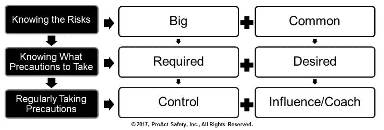A Visual Model to Simplify the Definition of Safety
To shape, control, and influence performance in any organization, clarity should exist around what employees are required to do and what is most desirable.
How is safety defined in your company? Most people respond to this question with a goal (such as not getting hurt or going home the same way they came to work) rather than a definition. If a group of people are going to work to accomplish a goal, it must be clearly defined and the definition universally shared.
Safety, simply put, is knowing what can hurt you, learning the things that can keep them from hurting you, and doing those things. This overly simplistic definition does not elaborate on the methodologies of mitigating risks, but it does focus on the basic objectives. It also provides a sensible framework to not only focus discussions to increase ownership, but also assist in developing new leading indicators for a company’s ever-maturing safety scorecard.
Knowing the Risks: Do your employees know the different types of risks they might face in their work area? What are the big risks, the where single exposure is likely to result in a serious injury or fatality? These types of risks are often categorized as high-probability. What are the common risks they will face? What risks are being taken that are common to the culture? These are typically low-probability types of risk. What risks are often taken that are less likely to result in an injury, but as an organization drastically improves in their approaches to safety and resulting performance, might make up a large part of their injuries? How well do your employees know both the big and common risks? Consider a quiz or a test to find out. The response can become a leading indicator for your safety scorecard.
Knowing What Precautions to Take: Merriam-Webster defines precaution as "care taken in advance" or "a measure taken beforehand to prevent harm or secure good." Do your employees know what precautions are required of them? Lockout/Tagout is an example. In most companies, this is not a gentle request; it is a requirement, and serious events occurred that led to this. The U.S. Navy has a saying, "All rules are written in blood." However, in an organization plagued by injuries that could largely be preventable by keeping eyes on path or task, it would be inefficient to try to write and enforce a rule that "You must look where you are going." Specifically, what precaution must someone take to control the big risks? And what precaution can someone take to control the common risks? To shape, control and influence performance in any organization, clarity should exist around what employees are required to do and what is most desirable. Do your employees know this? Their responses to a quiz could also become a leading indicator.

Regularly Taking Precautions
In my March 2017 article, "Four Questions to Shape Performance," I mention there must be a balance of consequences if a leader is to shape the performance of another person. How do you monitor required and desired precautions? If someone is doing what they are required to do, do you say something, or only if they are not? If someone is purposefully deviating away from a rule, policy or procedure, counseling is needed, not coaching. Leaders must control the behavior that is required. If desired precautions are known to overcome the common risks, how are they being coached? Work practice assessments, coaching, and behavioral observations have become common leading indicators.
To operationalize this model in your work environment, consider asking the following questions as part of your pre-shift huddles, job safety analysis, and safety meetings.
1. What are our big risks?
2. What are we required to do to address these risks?
3. What would make it difficult or impossible to take the required precautions?
4. What are our common risks?
5. What can we do within our control to address these risks?
6. What would make it difficult or impossible to take these desired precautions?
7. How will we ensure we are doing what is needed to make these precautions a habit?
The more individuals involved in discussions to identify risk, collaborate on what to do to overcome and protect against these risks, and develop mechanisms to watch out for and coach each other on the precautions being taken, the greater the knowledge about safety and ownership in the preventative activities the organization will experience. By listening to the responses to the questions found throughout this article, not only will you grow the hazard and risk knowledge and identification capabilities of the workforce, you will also proactively identify obstacles and barriers to safe practices.
This article originally appeared in the November 2017 issue of Occupational Health & Safety.